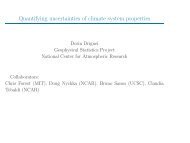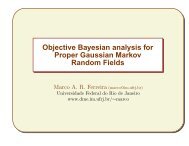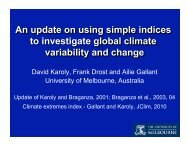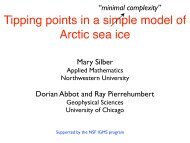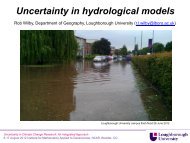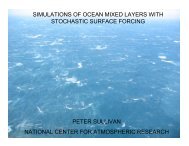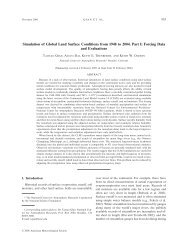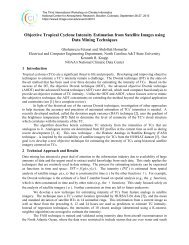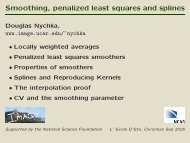A Spatial Analysis of Multivariate Output from Regional ... - IMAGe
A Spatial Analysis of Multivariate Output from Regional ... - IMAGe
A Spatial Analysis of Multivariate Output from Regional ... - IMAGe
You also want an ePaper? Increase the reach of your titles
YUMPU automatically turns print PDFs into web optimized ePapers that Google loves.
<strong>of</strong> these empirical relationships over long periods <strong>of</strong> time, especially with varying forcings(e.g., increasing CO 2 concentrations).Dynamical downscaling involves using high-resolution climate models. Of course, thereare limitations due to computational demands and a price to be paid for the higher resolution.One approach uses only the atmospheric component <strong>of</strong> a GCM with, for example,observed ocean temperatures. These so-called time-slice experiments are globally consistent,but they generally use many <strong>of</strong> the same formulations as the coarse-scale GCMs.<strong>Regional</strong> climate models (RCMs) are the focus <strong>of</strong> this research and are another dynamicalapproach based on high-resolution climate models. These models typical focus on alimited spatial domain, have grid boxes on the scale <strong>of</strong> 20 to 100 km, and there are <strong>of</strong>tensimplifications <strong>of</strong> ocean processes in these models. They also use initial conditions andtime-dependent lateral boundary conditions <strong>from</strong> the GCM (e.g., winds, temperature, andmoisture). Hence, global circulation and large-scale forcings are consistent with the GCM,but, with the higher-resolution forcings included (e.g., topography, land cover, etc.), thesemodels have the potential to actually enhance the simulation <strong>of</strong> climate on regional andlocal scales. Of course, RCMs can be influenced by potential biases in the GCM, and thereis a lack <strong>of</strong> two-way interactions between the driving GCM and the RCM.For those interested in understanding more about climate and climate change and globaland regional climate modeling, we refer them to the Intergovernmental Panel on ClimateChange (IPCC, http://www.ipcc.ch) assessment reports, and in particular to the contributions<strong>of</strong> Working Group I to the Third Assessment Report (Houghton et al., 2001) andthe Fourth Assessment Report (Solomon et al., 2007). These documents not only includeexcellent overviews <strong>of</strong> the issues but also numerous scientific references for more in-depthcoverage.1.2 A Statistical Representation <strong>of</strong> Climate-Model <strong>Output</strong>We propose a statistical model for combining the output <strong>from</strong> simple ensembles <strong>of</strong> RCMsin order to characterize the distribution <strong>of</strong> the model output. This statistical model will be4



